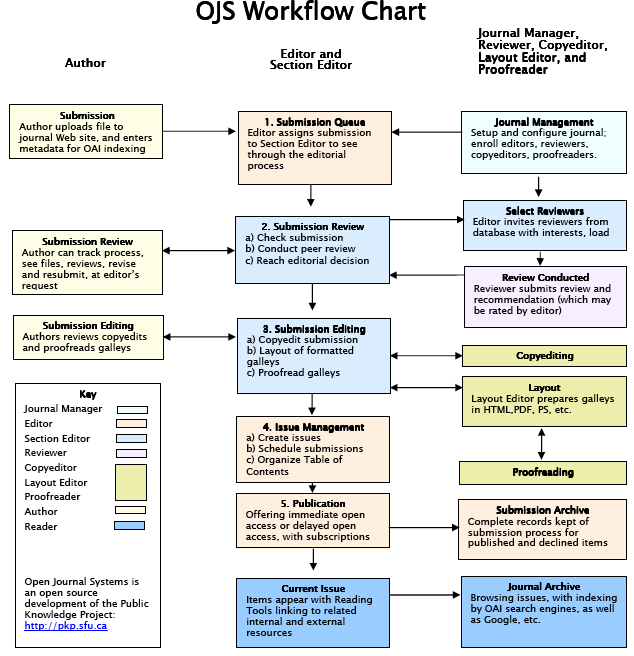
This blog covers the A to Z of OJS and how it gives journal publishers a competitive edge, especially those running their journals through Open Access (OA) routes.
Introduction: A Sneak-Peek into OJS
OJS, short for Open Journal Systems, is an open-source (free to use) software that enables authors and publishers to submit, edit, publish, archive, and manage peer-reviewed scholarly journals online. It is an end-to-end journal publishing and management system that can be easily operated by authors, reviewers, editors, or publishers.
Moreover, OJS’s latest upgrade enables you with more flexible roles and task management features. You can create new roles and modify, rename, or even rearrange the existing roles.
The PHP application developed originally by Public Knowledge Project (PKP) has been on a growth trajectory since its release in 2001. Used by 10,000+ journals worldwide, OJS provides a solid foundation to all journal publishers aiming to improve the quality of their scholarly publishing and expand the reach of research work.

However, to run your journals on the current version of OJS 3.x, you need to install and set up OJS on your web server first. If you are new to OJS and planning to host your journal on the platform, read our blog — A step-by-step guide to OJS installation.
Why Use OJS for Journal Publishing?
OJS is an application designed for reducing the time & effort editors or journal managers invest in executing administrative and clerical tasks. Editing a journal is a tedious job as it includes several editorial and review processes. OJS’s highly flexible and scalable architecture improves the overall efficiency of your editorial workflow, streamlines the record-keeping process, and enhances scholarly publishing quality.
While OJS offers publication of delayed and subscription-based journals, it is widely used by Open Access journals. It actively supports the policy of extending access to research papers to as many readers as possible.
Adoption of a fully open access model (also known as Gold OA) has so far been confined to small collections of the journal publishing realm. However, over time, many initiatives promoting OA publishing have asserted that open access is feasible and cost-efficient. It not only allows readers to discover and leverage relevant research content but also enables authors to accumulate vast readership, increase journal visibility, and make an impact.
“Scholars need the means to launch a new generation of journals committed to Open Access, and to help existing journals that elect to make the transition to Open Access.”
— Budapest Open Access Initiative (BOAI)
OJS strives to not only optimize the journal publishing workflow but also to demonstrate that embracing an Open Access model and making the research work openly available to readers will significantly reduce your journal production costs.
Benefits of using OJS
Leveraging OJS for managing and publishing your research journals benefits you in various ways:
- It facilitates online article submissions, including single-blind & double-blind peer reviews, content distribution to a global audience, and management of all journal articles.
- More importantly, it supports JATS XML standardization. Needless to say, articles formatted and published in JATS XML format get your journal increased visibility and readership.
- Using its Export tools, you can easily export article data to third-party agencies, databases, or systems such as CrossRef, PubMed, ORCID, DOAJ, and more.
- The OJS 3.x has a dynamic and more flexible editorial workflow that you can customize easily.
- The platform is optimized for content discovery across search engines such as Google, Google Scholar, etc., and provides comprehensive indexing of your journals.
- A secure environment for archiving and stewardship of scholarly content
- OJS also provides you a responsive, theme-based reader interface with multilingual support.
Understanding OJS Editorial and Publishing Workflow
The OJS workflow — from the first author submission to the final stage of publication — is branched into four different stages, as explained below:
- Submission: In this stage, new submissions from authors arrive for your journal and are assigned to Section Editors. They review, edit, and move the submissions to the Review stage. Submissions that fail to meet the journal standards and are clearly inapt do not get pushed to the next stage.
- Review: The peer review of author submissions is conducted in this stage, where the reviewers also suggest revisions required from the author’s end. Submissions that do not get accepted never make it beyond the review stage, and the approved articles move to the copyediting stage.
- Copyediting: Approved and reviewed articles land on the copyediting stage, where a copyeditor works on the submissions to improve grammar, rectify errors, and bring clarity to the article content. Copyeditors are also responsible for ensuring that the articles follow the journal’s textual guidelines and bibliographic style. Authors can review the copyedits made in their research papers.
- Production: Post the copyediting, accepted articles reach the production stage. The copyedited, production-ready article files are converted to galleys such as JATS XML, PDFs, HTML, etc. In this stage also, authors have the option to proofread the galleys of their articles. Once submissions pass through all the approvals, it is scheduled for publication in a future journal issue.
And that’s how the standard OJS workflow looks like.

However, for streamlined journal management, OJS administrators need to regularly review journal websites, check permissions, keep the “INDEXING” settings updated, etc. Check out this article piece on OJS Setup: Site administration and Journal Management to get a deeper understanding.
OJS Hosting — How to publish multiple journals on OJS cost-effectively
Open Journal Systems indeed has become the de facto standard platform for scholarly publishing but integrating your journal site with OJS requires expertise and training. Besides, bearing the burden of OJS server management internally and sustaining unnecessary operational costs is not a smart move.
SciSpace provides a cost-effective OJS hosting solution for university-run journals, institutional libraries, and scholarly societies.

The key features of SciSpace’s OJS Suite incorporate:
- If you are running more than one journal, then PKP hosting services will charge you on a per journal basis, which is expensive. Typeset’s OJS suite offers you unrestricted access to host multiple journals on OJS with multi-journal installation support at a minimal cost, per OJS instance basis. For a detailed pricing plan, read the blog.
- As your journal publishing needs grow, Typeset’s OJS Suite scales up automatically without any hidden extras to the pricing plan. It also includes unlimited articles (active and archived), unlimited storage, and unlimited users.
- It also provides access to OJS’s wide range of themes to pick and choose from. You can easily install all themes via Plugin Gallery that are mobile-friendly, responsive, and require less than two minutes to set up.
- Used by over 230 journals, the OJS Suite provides 100% uptime of your hosted journal website.
We recommend taking a look at SciSpace if you are looking for platforms to simplify research workflows. There are over 200 million articles covering many topics, along with summaries and profiles that let you display your expertise.

It enables you to evaluate the quality of a source by showing its references, citations, and performance metrics. The tool also helps you discover which topics are trending, who are the leading authors, and which publishers are on top.

Get started with SciSpace’s OJS Suite today and establish high-impact journals across the publishing world.






